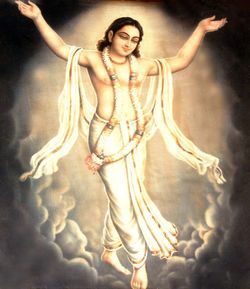Chaitanya Mahaprabhu (1486 - 1534), was a monk and social reformer of the 16th century Bengal, (present-day West Bengal and Bangladesh) and Orissa in India. Sri Krishna Chaitanya was a notable proponent for the Vaishnava school of Bhakti yoga (meaning loving devotion to Krishna / God) based on the philosophy of the Bhagavata Purana and Bhagavad Gita. Specifically he worshipped the forms of Radha and Krishna and popularised the chanting of the Hare Krishna maha mantra. His line of followers, known as Gaudiya Vaishnavas, revere him as an avatar of Krishna in the mood of Radharani who was prophesised to appear in the later verses of the Bhagavata Purana. He was also sometimes referred to by the names Gaura, Sanskrit for 'golden one; due to his light skin complexion, and Nimai due to his being born underneath a Neem tree. There are numerous biographies available from the time giving details of Chaitanya's life, the most prominent ones being the Chaitanya Charitamrita of Krishnadas Kaviraja Goswami and the earlier Chaitanya Bhagavata of Vrindavan.
- Das Thakur (both originally written in the Bengali language but now widely available in English and other languages) and the Chaitanya Mangala, written by Lochana Das Thakur.
- According to the biography, Chaitanya Charitamrita, Nimäi appeared on the full moon night of February 18th 1486 at the time of a lunar eclipse. His parents named him 'Visvambhar'- He was the second son of Jagannath Mishra and his wife Sachi Devi who lived in the town of Nabadwip in Nadia, West Bengal.
- Chaitanya's ancestry is a contentious issue between the people of Orissa and West Bengal with Shree Chaitanya having family roots in Jaipur, Orissa, from where His grandfather, Madhukar Mishra had emigrated to nearby Bengal.
Contents
- 1 Birth and Parentage
- 2 Boyhood and Education
- 3 Death of Gauranga's Father and Marriage
- 4 The Turning Point in Gauranga's Life
- 5 Scholastic Career
- 6 The Civil Disobedience Movement
- 7 Chaitanya's Teachings
- 8 Chaitanya's Mission - The Universal Religion
- 9 Chaitanya’s Pilgrimages
- 10 References
- 11 Related Articles
Birth and Parentage
Sri Chaitanya Mahaprabhu, also known as, Lord Gauranga was born to Pandit Jagannath Misra and Sachi Devi at Nabadwip, on the full moon (lunar eclipsed) evening of February 18, 1486 (23rd day of the month of Falgun in the year 1407 of the Sakabda era). His father was a pious Brahmin immigrant from Sylhet, Bangaldesh, who settled in Nabadwip in the Nadia district of West Bengal north of Kolkata by the holy Ganges, and his mother was the daughter of the scholar Nilambar Chakraborty.He was the tenth child of his parents and was named Viswambar. Before his birth, his mother lost a number of children. So, he was given the name "Nimai" after the bitter Neem tree as a protection against evil influences. The neighbors called him "Gaur" or "Gauranga" (Gaur = fair; Anga = body) because of his fair-complexion.[1]
Boyhood and Education
Gouranga studied logic at the school of Vasudev Sarvabhauma, a reputed professor of 'Nyaya' - the ancient Indian science of law and logic. The extraordinary intellect of Gauranga attracted the attention of Raghunath, author of the famous book on logic - Didheeti. Raghunath thought that he was the most intelligent youth in the world - even more cerebral than his teacher Sarvabhauma. Gauranga mastered all branches of Sanskrit learning such as grammar, logic, literature, rhetoric, philosophy and theology. He then started a 'Tol' or place of learning at the age of 16 - the youngest professor to be in charge of a 'Tol.' Gauranga was a kind and compassionate, and a pure and gentle youth. He was a friend of the poor, and lived a very simple life.[1]





